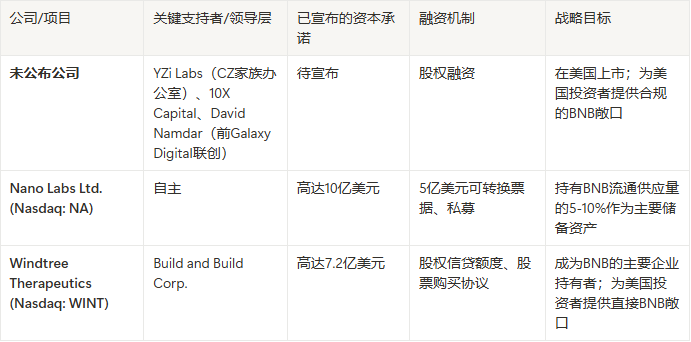Written by: Luke, Mars Finance
Recently, BNB's price trend has broken its long-standing silence, impressively breaking through $850 and continuously setting new historical records. This surge has sparked widespread market discussion and exploration, with many observers feeling puzzled, as a market accustomed to stablecoin-like fluctuations suddenly finds it difficult to understand the driving forces behind it. However, the surface-level price surge is merely the tip of the iceberg, potentially reflecting a carefully planned, fundamental strategic shift: BNB is transforming from a functional token deeply bound to a single exchange to an institutional-level reserve asset oriented towards traditional capital markets, backed by the balance sheets of multiple listed companies.
[The rest of the translation follows the same professional and accurate approach, maintaining the original meaning while translating into fluent English.]Meanwhile, a market rumor sparked widespread discussion: "CZ established a listed company with 28% ownership, self-financing a BNB micro-strategy". The rumor quickly spread, suggesting CZ was directly orchestrating behind the scenes. Facing market speculation, CZ himself succinctly responded with one word on social media X (formerly Twitter): "scam / fake". This response initially confused the market, but soon, more detailed analysis clarified the facts: CZ's response was not denying the entire BNB reserve strategy, but precisely refuting the inaccurate information that "he personally established a listed company and raised funds". A closer interpretation is that there is indeed a new company with BNB as a strategic reserve, with David Namdar as CEO, 10X Capital as asset manager, and CZ's family office YZi Labs as an investor, rather than a direct operator. This distancing both aligns with CZ's current legal status and explains why he defined rumors directly attributed to him as "fake".

Beyond this main thread, a "pioneer fleet" composed of trailblazers has set sail, demonstrating impressive capital firepower. Nasdaq-listed Chinese chip design company Nano Labs announced a $1 billion BNB acquisition plan, funded by a $500 million convertible note issuance, targeting to hold 5% to 10% of BNB's circulating supply. Recently, the company has purchased 120,000 BNB through over-the-counter (OTC) trading, with a total value of approximately $90 million. Another Nasdaq-listed company, biotechnology firm Windtree Therapeutics, also announced a transformation, securing up to $720 million in financing commitments, mostly to be used for purchasing and holding BNB.
What truly revealed the scale of ambition was information CZ disclosed on another occasion: "Over 30 teams" are exploring establishing BNB reserve asset listed companies. This indicates that what we're seeing is no longer isolated cases, but an emerging, coordinated capital movement.

Compared to TRON's single-point breakthrough approach, BNB's "constellation" strategy is clearly more advanced. By nurturing a decentralized network of listed companies, it builds a more resilient and scalable capital bridge. This structure disperses risks, avoids dependence on a single entity, and creates continuous demand for BNB from multiple dimensions, representing a profound practice of applying Web3 decentralization thinking to solving traditional financial interface problems.
Multi-Win: Building a Value Flywheel
Behind this strategic shift lies a precise, multi-win value model. It cleverly combines BNB assets, core stakeholders, and traditional capital market needs, forming a powerful positive cycle.
First, for the BNB asset itself, this strategy creates an unprecedented "permanent demand pool". When BNB is written into multiple listed companies' balance sheets, its identity transforms from a simple, blockchain activity-dependent functional token to a digital commodity or strategic reserve asset endorsed by institutions. These purchases by listed companies, typically driven by capital market tools like stock or convertible bond issuances, are structural and long-term, not short-term speculative actions. This provides a solid price support for BNB and introduces a grand narrative based on institutional asset allocation to its valuation model.
Second, for CZ and the entire ecosystem, this is an extremely wise layout in the post-regulatory and settlement era. By investing and supporting through his family office YZi Labs, he can maintain legal and operational distance from the Binance exchange where he has resigned as CEO, thereby complying with legal agreements while continuing to promote the BNB ecosystem. As one of BNB's largest holders, this strategy allows the value of his core assets to rise with the success of the entire "BNB reserve constellation" without directly selling tokens in the open market, perfectly balancing personal legal constraints with maximizing ecosystem economic influence.
Finally, for traditional capital markets, this model solves the core "access" challenge. Many institutional and individual investors cannot directly invest in crypto assets due to compliance and custody issues. However, purchasing a stock traded on Nasdaq, such as Nano Labs (NA) or Windtree (WINT), is a simple, mature, and fully compliant operation. These listed companies act like a "converter", encapsulating the complexity of the crypto world, providing a seamless interface for traditional capital, potentially guiding trillions of global stock market funds into the BNB ecosystem.
Dawn of a New Paradigm
In summary, BNB's recent price breakthrough is not groundless. It is an external signal of BNB's profound transformation: from a compliance-constrained exchange functional token to an institution-level reserve asset supported by public market capital. This transformation path, rather than through traditional direct IPO, borrows from and surpasses TRON's financial techniques, innovatively building a "reserve asset constellation" composed of multiple listed companies.
This model is poised to form a powerful value flywheel: listed companies buy BNB, driving price increases; rising BNB prices enhance these companies' asset values, thereby boosting their stock prices; higher stock prices make it easier to raise capital market funds; newly raised funds can then be used to purchase more BNB. Once this self-reinforcing cycle forms, it will provide continuous growth momentum for BNB.
More profoundly, BNB's practice might signal the birth of a new paradigm - "Asset-Backed Network". In this model, the value of a mature decentralized network is no longer defined solely by its on-chain economic activity, but more by the assets anchored behind it and flowing in compliant capital markets. This perhaps points to a new direction for how mainstream crypto ecosystems can deeply integrate with the global financial system and draw strength from it. Therefore, BNB's historical new high might not be the endpoint of this market trend, but the beginning of a more grand narrative.








